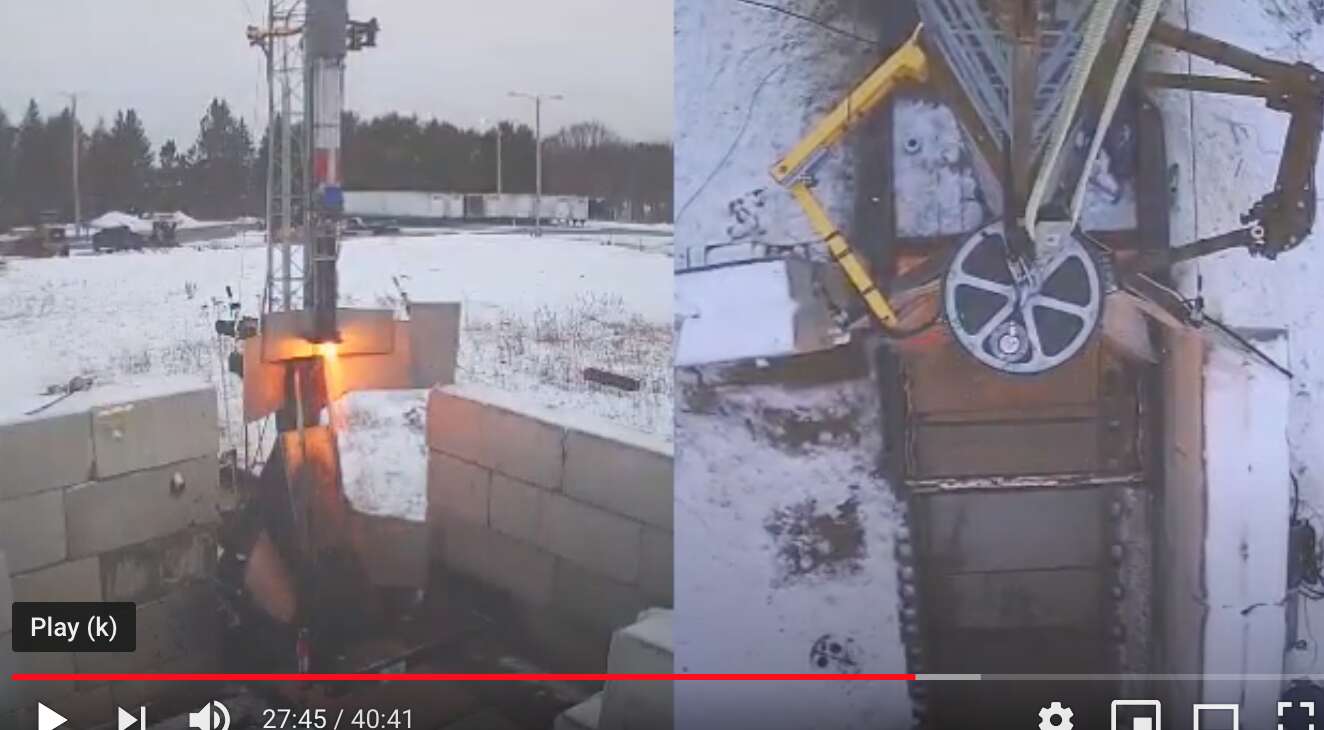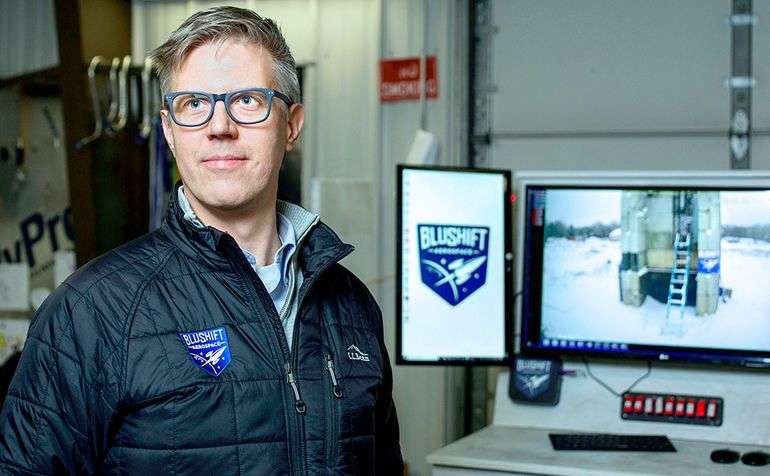
Processing Your Payment
Please do not leave this page until complete. This can take a few moments.
Brunswick rocket-maker tests engine, expects to launch rocket soon
 Screenshot / bluShift Aerospace
This screenshot from the livestream shows the engine test burning behind a blast wall. In front of the wall is the payload section of the rocket.
Screenshot / bluShift Aerospace
This screenshot from the livestream shows the engine test burning behind a blast wall. In front of the wall is the payload section of the rocket.
bluShift Aerospace’s successful test Tuesday afternoon of its hybrid rocket engine puts the Brunswick company in position to launch its first rocket prototype, likely later this month.
Called a “static fire test” because the engine is secured so it can’t move, the test occurred within a concrete blast wall in a field at Brunswick Landing, where bluShift is headquartered. A blast of combustion lasted for a few seconds, followed by smoke and then an afterburn. The test was livestreamed. One commenter wrote, “I hope bluShift puts New England on the map as a orbital launch site.”
Click here to view the test.
First commercial launch
Tested was bluShift’s Modular Adaptable Rocket Engine for Vehicle Launch, or MAREVL for short.
The engine was controlled by flight computer and secured in place on a launch tower.
The test was deemed 100% effective, putting bluShift in the position of using MAREVL to power blueShift’s Stardust 1.0 prototype rocket in a forthcoming flight from the Loring Commerce Centre in Limestone.
That flight will be the world’s first commercial launch of a rocket powered by biofuel, according to bluShift.
The low-altitude technology-demonstration launch will culminate years of research and development, over 200 engine tests, the completion of grants from NASA and the Maine Technology Institute, and the development of the MAREVL, which is a modular hybrid rocket engine powered by a carbon-neutral, bio-derived fuel.
The rockets are ultimately being developed to carry nanosatellites into suborbital space.
Nanosatellites are small satellites weighing up to a couple dozen pounds. Inexpensive to make, they can carry electronics and sensors for a broad range of applications, primarily earth observation and communications.
A growing segment of companies, including powerhouses like Richard Branson’s Virgin Orbit, is developing small rockets that will deploy nanosatellites into an orbital configuration of the customer’s choosing and on the customer’s timetable. The rocket then returns to earth.

First in Maine
bluShift Aerospace is one of those companies. It aims to launch Stardust 1.0 in early 2021, CEO and founder Sascha Deri told Mainebiz.
“If we’re able to take this successful step, as one investor told me, it takes us from being the child in the rocket industry to being a fully developed adolescent,” Deri said of the coming launch. “I believe we’re the first company in Maine to have built a rocket and launch it with paying customers.”
For the first launch, bluShift has three customers. One is a group of Falmouth High School students who, supported by their science teachers, built a basic experiment to measure factors such as pressure, acceleration and temperature as the rocket ascends.
“They handed us their experiment for launch two weeks ago,” Deri said.
The second is Kellogg’s Research Lab in Nashua, N.H., which is working with a material designed to absorb vibration and convert it into heat, he said. The lab wants to demonstrate the material can do that in the real-world application of an accelerating rocket.
“Rockets often experience quite a bit of vibration and they’ll be measuring that,” Deri said.
The third customer is for fun. Rocket Insights Inc., an app builder with offices in Massachusetts and elsewhere, is sending up a batch of a Dutch cookie called stroopwafel.
“They just wanted to support our launch,” Deri said with a laugh, noting that the company’s parent is based in The Netherlands. “They’ve asked to get the stroopwafel back and they’ll sample the vibration it experienced. It’s not an official experiment. They’ve also sent us a canister of tourmaline. They want to have the ultimate rocket rock tumbler.”

The experiments will be loaded into metal enclosures that are similar to a cubesat form, Deri said.
A cubesat is a small nanosatellite, usually weighing less than 3 pounds and typically costing just hundreds or thousands of dollars to produce. They can easily operate in networked “swarms” with the same functionality of a single large satellite.
One advantage of a swarm is that even the total failure of several cubesats may still allow the swarm to function normally, according to bluShift.
Up a mile
The upcoming Stardust 1.0 launch won’t go anywhere near suborbital space, said Deri.
“This will be a demonstration to show our engine works, that we can get paying customers, and hopefully that it goes successfully and we can recover the payloads,” he said.
The launch will go up 1 mile, the limit allowed at Loring for Federal Aviation Administration purposes.
Future launches will likely occur off the eastern coast of Maine, he said. For that, the plan under consideration is to purchase a barge to launch from, at least a mile and a half off the coast.
“We need to be away from people, homes and structures,” he said. “We also are cognizant that we need to be respectful of local fishermen and coordinate with them. We have a strong possibility of one place.”
The goal is to purchase the barge and launch the company’s second prototype, called Stardust 2.0, by the end of 2021, he said. The rocket could go anywhere from 35 to 60 mile in altitude.
“We expect to get paying customers for that, too,” he added.
Stepping stones
The two prototypes — Stardust 1.0 and 2.0 – are stepping stones to the company’s commercial launch vehicles. The commercial vehicles, offering suborbital launch services, are expected to go at least four times higher than 60 miles, he said.
That means the rocket goes to space, deploys the cubesats, then parachutes back down to the ocean.
The name of the first commercial launch vehicle will be Starless Rogue. (See sidebar for rockets specs.)
Investment in product development has been over $500,000 to date; Deri has put in about half of that. The team has seven full-time employees. Two of the engineers receive a salary; the rest of the team, including Deri, works for equity in the company.
The company has also hired three interns from Maine colleges. It’s open to high school interns as well, he added.
“We’re the most active rocket company in Maine — and we’ve been able to give our interns an incredible experience in everything from putting together parts of the rocket to developing communication systems,” he said.
Deri said he plans to next seek a convertible note round of about $550,000 to $600,000 and is talking with angel investors in the Northeast and beyond.
“We’ll be pitching hard after the launch,” he said. “That money should get us about eight months of burn time and to the point where we’re about ready to launch Stardust 2.0 before the end of 2021.”
Toward the end of 2021, he plans to seek a first seed round $5.5 million.
“At that point, we’ll be bustling to build Starless Rogue,” he predicted.
By 2023, he said, he expects to open a Series A round of $7.7 million. About a year after that, he expects the company will be positioned to offer commercial launch service in the company’s next rocket iteration, called Red Dwarf, for customers he expects will be mostly academic and civil research outfits.
At that point, he said, he expects the company to be profitable and able to hire more staff and support development of future technology.
“At that point, we believe we’ll be in full swing,” he said.
bluShift expects to create over 40 aerospace jobs in Maine in the next five years.
‘Secret-sauce’ biofuel
The development of biofuel was perfected by late 2019, he said. What type of material goes into it?

“I can’t say what the secret sauce is, but it can be derived from many farms across America,” he said. “There’s no reason we couldn’t derive it solely from sources in Maine.”
Deri grew up in Orland, Orono and Bucksport, then earned a degree in physics from Earlham College and a second degree in electrical engineering from University of Southern Maine. He now lives in Brunswick.
In 1999, he co-founded altE, a national renewable energy product distribution and light manufacturing company.
He launched bluShift in 2014.









0 Comments